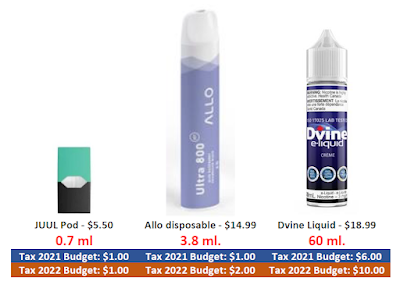The Ontario Student Drug Use and Mental Health Survey (OSDUHS) [1] has been conducted by CAMH every second year for an impressive 45 years. The Ontarians who were contemplating high school graduation when it was first in the field in 1977 will now be preparing for retirement!
Questions on tobacco use were included in the first survey in 1977 and questions on e-cigarette use were added in 2015. Unlike many surveys which use past-month use as the main indicator (e.g. 'current smoking'), this survey focuses on use during the past 12 months.
As would be expected the questions on the survey and the manner of collecting data have evolved over the decades. The impact of COVID-19 restrictions triggered significant changes between 2019 and 2021 and resulted in a drastically reduced response rate. This cycle of the survey had the smallest sample size in the survey's history. The authors warn "because of the significant changes to the methodology in 2021, caution is warranted when comparing these estimates with those from previous OSDUHS cycles."
In 2019 - 14,142 students in grades 7 to 12 from 992 classes in 263 schools in 47 school boards participated in the survey between November of 2018 and June 2019. [2]
In 2021 - 2,225 students in grades 7 to 12 from 122 schools in 31 school boards completed the survey online (from any location at any time) between March and June 2021.
The survey found significant reductions in vaping and dridnking, but not for using tobacco, cannabis or opioidsThe caution on comparisons should be kept in mind when reviewing the decline in many indicators of concern. The survey found a statistically significant decrease in vaping and alcohol, but the drop in past-year cigarette smoking (from 5% to 4.1%) and cannabis use (from 22.0% to 17.0%) was not statistically significant.
The survey found that many Ontario high school students think it is easy to get access to nicotine.
Just over one-half (56%) of students reported it they thought it is "fairly easy" or "very easy" to get e-cigarettes, and just under one-half (45%) had that view for tobacco.
The survey paints an asymptotic approach to ending youth tobacco smoking, and a return to higher rates of nicotine use.
Each successive wave of the OSDUHS since 1995 has shown a decrease in the percentage of students in grades 7 - 11 who have smoked in the past year, but the rate of decline is slowing.
Even with the reported declines in vaping behaviour, overall nicotine use in 2021 appears to be greater than it was in 2005, when 14.4% of high school students smoked cigarettes (and alternative product use, like hookah and cigarillos, had not yet emerged as a measurable problem).
Historic data, shown below, is available for grades 7 to 11 for the years 1977 to 2017 and for grades 7 to 12 for the years 1995 to 2021. [3]
[1] CAMH. Findings from the 2021 Ontario Student Drug Use and Health Survey. https://www.camh.ca/-/media/files/pdf---osduhs/2021-osduhs-report-pdf.pdf
[2] CAMH. Detailed Findings from the 2019 Ontario Student Drug Use and Health Survey. https://www.camh.ca/-/media/files/pdf---osduhs/drugusereport_2019osduhs-pdf.pdf?la=en&hash=7F149240451E7421C3991121AEAD630F21B13784
[3] CAMH. Detailed Findings from the 2019 Ontario Student Drug Use and Health Survey. 1977-2017
https://www.champlainpathways.ca/wp-content/uploads/2018/01/Detailed_DrugUseReport_2017OSDUHS.pdf
[4] Tables for Poll conducted by Research Co. on Vaping in Canada - April 26, 2022
https://researchco.ca/wp-content/uploads/2022/04/Tables_Vaping_CAN_26Apr2022.pdf
[5] Tables for Poll conducted by Research Co. on Vaping in Canada - October 2020
https://researchco.ca/wp-content/uploads/2020/10/Tables_Smoking_CAN_27Oct2020.pdf
[6] Tables for Poll conducted by Research Co. on Vaping in Canada - November 2019
https://researchco.ca/wp-content/uploads/2019/11/Tables_Vaping_CAN_13Nov2019.pdf
[7] Tables for Poll conducted by Research Co. on Vaping in Canada - November 2018
https://researchco.ca/wp-content/uploads/2018/11/Tables_Vaping_21Nov2018.pdf



















